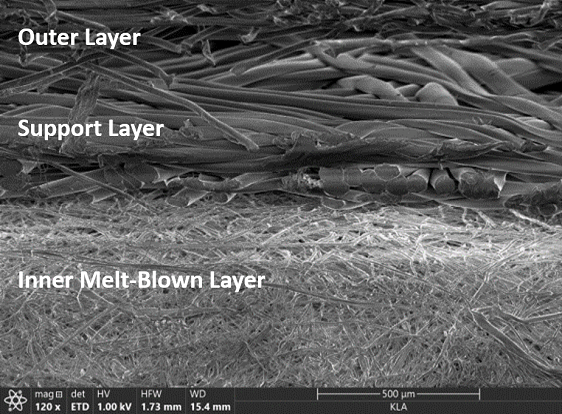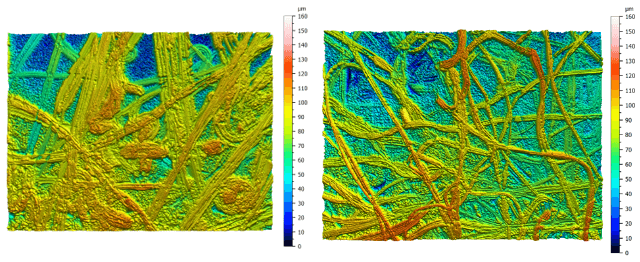As the United States grappled with multiple surges in COVID-19 cases last year, American healthcare facilities adopted crisis capacity decontamination strategies issued by the Center for Disease Control (CDC), including reuse of their N95 masks. Mask cleaning and reuse kept workers and patients safe through supply shortages. But could decontaminating a mask multiple times affect its structure and thus the safety it provides? KLA’s dedication to research and humanity inspired us to investigate this question. Equipped with a broad and powerful portfolio of measurement and inspection tools, the KLA Instruments team set out to study the effects of disinfection on N95 mask fibers in a series of experiments involving nanoindentation and imaging.
Background
N95 filtering facepiece respirator (FFR) face masks are typically composed of multiple filtration layers. The inner filtration layer is considered the key component in protecting wearers (Figure 1).

The National Institute for Occupational Safety and Health (NIOSH) recommends ultraviolet germicidal irradiation (UVGI) to disinfect N95 FFRs for reuse. The necessary UV dose needed to decontaminate the inner mask layer is several hundred times higher than the dose required for virus inactivation in the air or on surfaces. This process may lead to polymer degradation, posing a risk of damage to the N95 respirator materials following multiple decontamination cycles.
Experiment
The KLA Instruments team set out to test the nanomechanical and topographic properties of a 3M 9211+ Aura Particulate Disposable Respirator Mask to see if repeatedly disinfecting the mask with ultraviolet C (UVC) light produced changes that suggested a decrease in the mask’s overall effectiveness. After cutting the inner layer of the mask into six 1cm square samples, the scientists placed five of the samples into a chamber and exposed them to UVC light for 5 to 155 minutes. These varied exposure times created five different test conditions. The sixth sample was untreated as a control.
The team used the Nano Indenter® G200X , equipped with the NanoVision option, to help position the measurements accurately and measure force vs. distance curves as a continuous function of penetration depth for multiple individual fibers of the N95 samples (Figure 2). From these measurements, the system determined Young’s modulus and hardness as a function of exposure (Figure 3).

Right: Figure 3. Hardness (H), Young’s Modulus (E) and fiber width are shown as a function of cumulative UVC dose for N95 polypropylene fibers. The fiber width displays a strong logarithmic decrease with increase in dose.
The researchers followed the nanomechanical measurements with topographic and fiber width measurements using a Zeta-20 optical profiler. The team measured five different sites and five fibers per site for a total of 25 measurements per dose. From the profiler images, they extracted the changes in average fiber width as a function of UVC dose (Figure 4).

Results
Using KLA’s nanoindentation and imaging technology, our researchers were able to gather in-depth measurements on the effects of repeat disinfections on N95 mask fibers. As the world’s healthcare organizations continue to battle COVID-19 and its evolving variants, frontline workers may be asked to reuse personal protective equipment like N95 masks again. Understanding the effects of disinfection on the integrity of N95 mask fibers can help determine the maximum number of disinfections permitted before protection is reduced below required safety levels. Details of the experiment, including relevant data and potential for future research, can be found in the full study, published on MRS Advances. We encourage those interested in performing experiments based on nanoindentation and imaging to browse the KLA Instruments website and contact the sales team for more product information.
Follow Us